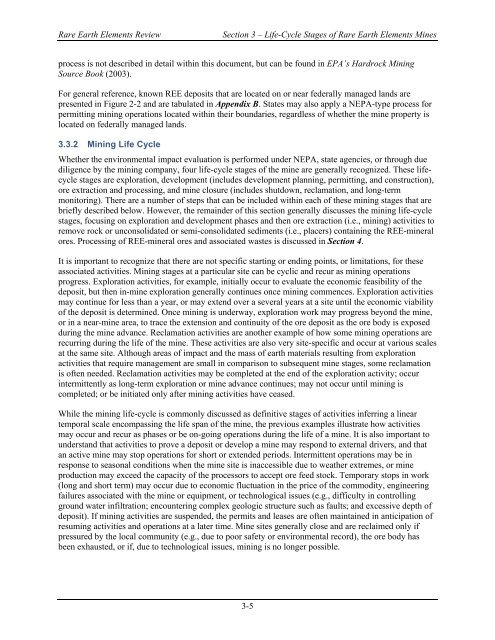Rare Earth Elements: A Review of Production, Processing ...
Rare Earth Elements: A Review of Production, Processing ...
Rare Earth Elements: A Review of Production, Processing ...
Create successful ePaper yourself
Turn your PDF publications into a flip-book with our unique Google optimized e-Paper software.
<strong>Rare</strong> <strong>Earth</strong> <strong>Elements</strong> <strong>Review</strong> Section 3 – Life-Cycle Stages <strong>of</strong> <strong>Rare</strong> <strong>Earth</strong> <strong>Elements</strong> Mines<br />
process is not described in detail within this document, but can be found in EPA’s Hardrock Mining<br />
Source Book (2003).<br />
For general reference, known REE deposits that are located on or near federally managed lands are<br />
presented in Figure 2-2 and are tabulated in Appendix B. States may also apply a NEPA-type process for<br />
permitting mining operations located within their boundaries, regardless <strong>of</strong> whether the mine property is<br />
located on federally managed lands.<br />
3.3.2 Mining Life Cycle<br />
Whether the environmental impact evaluation is performed under NEPA, state agencies, or through due<br />
diligence by the mining company, four life-cycle stages <strong>of</strong> the mine are generally recognized. These lifecycle<br />
stages are exploration, development (includes development planning, permitting, and construction),<br />
ore extraction and processing, and mine closure (includes shutdown, reclamation, and long-term<br />
monitoring). There are a number <strong>of</strong> steps that can be included within each <strong>of</strong> these mining stages that are<br />
briefly described below. However, the remainder <strong>of</strong> this section generally discusses the mining life-cycle<br />
stages, focusing on exploration and development phases and then ore extraction (i.e., mining) activities to<br />
remove rock or unconsolidated or semi-consolidated sediments (i.e., placers) containing the REE-mineral<br />
ores. <strong>Processing</strong> <strong>of</strong> REE-mineral ores and associated wastes is discussed in Section 4.<br />
It is important to recognize that there are not specific starting or ending points, or limitations, for these<br />
associated activities. Mining stages at a particular site can be cyclic and recur as mining operations<br />
progress. Exploration activities, for example, initially occur to evaluate the economic feasibility <strong>of</strong> the<br />
deposit, but then in-mine exploration generally continues once mining commences. Exploration activities<br />
may continue for less than a year, or may extend over a several years at a site until the economic viability<br />
<strong>of</strong> the deposit is determined. Once mining is underway, exploration work may progress beyond the mine,<br />
or in a near-mine area, to trace the extension and continuity <strong>of</strong> the ore deposit as the ore body is exposed<br />
during the mine advance. Reclamation activities are another example <strong>of</strong> how some mining operations are<br />
recurring during the life <strong>of</strong> the mine. These activities are also very site-specific and occur at various scales<br />
at the same site. Although areas <strong>of</strong> impact and the mass <strong>of</strong> earth materials resulting from exploration<br />
activities that require management are small in comparison to subsequent mine stages, some reclamation<br />
is <strong>of</strong>ten needed. Reclamation activities may be completed at the end <strong>of</strong> the exploration activity; occur<br />
intermittently as long-term exploration or mine advance continues; may not occur until mining is<br />
completed; or be initiated only after mining activities have ceased.<br />
While the mining life-cycle is commonly discussed as definitive stages <strong>of</strong> activities inferring a linear<br />
temporal scale encompassing the life span <strong>of</strong> the mine, the previous examples illustrate how activities<br />
may occur and recur as phases or be on-going operations during the life <strong>of</strong> a mine. It is also important to<br />
understand that activities to prove a deposit or develop a mine may respond to external drivers, and that<br />
an active mine may stop operations for short or extended periods. Intermittent operations may be in<br />
response to seasonal conditions when the mine site is inaccessible due to weather extremes, or mine<br />
production may exceed the capacity <strong>of</strong> the processors to accept ore feed stock. Temporary stops in work<br />
(long and short term) may occur due to economic fluctuation in the price <strong>of</strong> the commodity, engineering<br />
failures associated with the mine or equipment, or technological issues (e.g., difficulty in controlling<br />
ground water infiltration; encountering complex geologic structure such as faults; and excessive depth <strong>of</strong><br />
deposit). If mining activities are suspended, the permits and leases are <strong>of</strong>ten maintained in anticipation <strong>of</strong><br />
resuming activities and operations at a later time. Mine sites generally close and are reclaimed only if<br />
pressured by the local community (e.g., due to poor safety or environmental record), the ore body has<br />
been exhausted, or if, due to technological issues, mining is no longer possible.<br />
3-5















